Lavender Breeding for Winter Hardiness in a Temperate Climate
Abstract
1. Introduction
2. Materials and Methods
2.1. Plant Materials
2.2. Plants Winter Hardiness Assessment
2.3. Climatic Conditions Analysis
2.4. Statistical Analysis
3. Results
3.1. Analysis of Lavender Hybrids’ Winter Hardiness in Research Years
3.2. Climatic Conditions Analysis
- (1)
- Absence of snow cover and temperature decrease below zero (blue vertical arrows);
- (2)
- Sufficient snow cover and increase in temperatures to positive values (red vertical arrows);
- (3)
- Formation of a dense layer of snow with prolonged preservation of positive temperatures and subsequent decrease in temperatures to negative values (red double-sided horizontal arrow).
3.3. Relationship Between Winter Hardiness and Winter Climatic Conditions
4. Discussion
5. Conclusions
Author Contributions
Funding
Data Availability Statement
Acknowledgments
Conflicts of Interest
References
- Blankespoor, J. Lavender’s Medicinal and Aromatherapyuses and Lavender Truffles; Chestnut School of Herbal Medicine: Weaverville, NC, USA, 2012. [Google Scholar]
- Mokhtarzadeh, S.; Hajyzadeh, M.; Ahmad, H.; Khawar, K.M. The problems in acclimatisation of in vitro multiplied plants of Lavandula angustifolia Miller under field conditions. Acta Hortic. 2013, 988, 71–76. [Google Scholar] [CrossRef]
- Lis-Balchin, M. Lavender. In Handbook of Herbs and Spices; Elsevier: Amsterdam, The Netherlands, 2012; pp. 329–347. [Google Scholar]
- Adaszyńska, M.; Swarcewicz, M.; Markowska-Szczupak, A. Comparison of the chemical composition and antimicrobial activity of essential oil obtained from various domestic varieties of narrow-leaved lavender (Lavandula angustifolia L.). Postępy Fitoter. 2013, 2, 90–96. [Google Scholar]
- Bejar, E. Adulteration of english lavender (Lavandula angustifolia) essential oil. J. Pharm. Biomed. Anal. 2020, 199, 114050. [Google Scholar]
- Détár, E.; Németh, É.Z.; Gosztola, B.; Demján, I.; Pluhár, Z. Effects of variety and growth year on the essential oil properties of lavender (Lavandula angustifolia Mill.) and lavandin (Lavandula x intermedia Emeric ex Loisel.). Biochem. Syst. Ecol. 2020, 90, 104020. [Google Scholar] [CrossRef]
- Gallotte, P.; Fremondière, G.; Gallois, P.; Bernier, J.-P.B.; Buchwalder, A.; Walton, A.; Piasentin, J.; Fopa-Fomeju, B. Lavandula angustifolia Mill. and Lavandula x Intermedia Emeric Ex Loisel: Lavender and Lavandin. In Medicinal, Aromatic and Stimulant Plants; Novak, J., Blüthner, W.-D., Eds.; Handbook of Plant Breeding; Springer International Publishing: Cham, Switzerland, 2020; pp. 303–311. ISBN 978-3-030-38792-1. [Google Scholar]
- Pokajewicz, K.; Białoń, M.; Svydenko, L.; Fedin, R.; Hudz, N. Chemical Composition of the Essential Oil of the New Cultivars of Lavandula angustifolia Mill Bred in Ukraine. Molecules 2021, 26, 5681. [Google Scholar] [CrossRef]
- Miastkowska, M.; Kantyka, T.; Bielecka, E.; Kałucka, U.; Kamińska, M.; Kucharska, M.; Kilanowicz, A.; Cudzik, D.; Cudzik, K. Enhanced Biological Activity of a Novel Preparation of Lavandula angustifolia Essential Oil. Molecules 2021, 26, 2458. [Google Scholar] [CrossRef]
- Giray, F.H. An Analysis of World Lavender Oil Markets and Lessons for Turkey. J. Essent. Oil Bear. Plants 2018, 21, 1612–1623. [Google Scholar] [CrossRef]
- Ciesielska, K.; Ciesielski, W.; Girek, T.; Kołoczek, H.; Oszczęda, Z.; Tomasik, P. Reaction of Lavandula angustifolia Mill. to Water Treated with Low-Temperature, Low-Pressure Glow Plasma of Low Frequency. Water 2020, 12, 3168. [Google Scholar] [CrossRef]
- Lis-Balchin, M.; Hart, S. Studies on the mode of action of the essential oil of Lavender (Lavandula angustifolia P. Miller). Phytother. Res. 1999, 13, 540–542. [Google Scholar] [CrossRef]
- Dezici, S. Promising anticancer activity of lavender (Lavandula angustifolia Mill.) essential oil through induction of both apoptosis and necrosis. Ann. Phytomed. 2018, 7, 38–45. [Google Scholar]
- Cavanagh, H.M.A.; Wilkinson, J. Biological activities of lavender essential oil. Phytother. Res. 2002, 16, 301–308. [Google Scholar] [CrossRef] [PubMed]
- Kasper, S.; Gastpar, M.; Müller, W.E.; Volz, H.P.; Möller, H.J.; Dienel, A.; Schläfke, S. Silexan, an orally administered Lavandula oil preparation, is effective in the treatment of ‘subsyndromal’ anxiety disorder: A randomized, double-blind, placebo controlled trial. Int. Clin. Psychopharm. 2010, 25, 277–287. [Google Scholar] [CrossRef]
- Rastogi, S.; Shah, S.; Kumar, R.; Vashisth, D.; Akhtar, M.Q.; Kumar, A.; Dwivedi, U.N.; Shasany, A.K. Ocimum metabolomics in response to abiotic stresses: Cold, flood, drought and salinity. PLoS ONE 2019, 14, e0210903. [Google Scholar] [CrossRef] [PubMed]
- Manukyan, A. Effects of PAR and UV-B radiation on herbal yield, bioactive compounds and their antioxidant capacity of some medicinal plants under controlled environmental conditions. Photochem. Photobiol. 2013, 89, 406–414. [Google Scholar] [CrossRef] [PubMed]
- Mansinhos, I.; Gonçalves, S.; Romano, A. How climate change-related abiotic factors affect the production of industrial valuable compounds in Lamiaceae plant species: A review. Front. Plant Sci. 2024, 15, 1370810. [Google Scholar] [CrossRef] [PubMed]
- Crișan, I.; Ona, A.; Vârban, D.; Muntean, L.; Vârban, R.; Stoie, A.; Mihăiescu, T.; Morea, A. Current Trends for Lavender (Lavandula angustifolia Mill.) Crops and Products with Emphasis on Essential Oil Quality. Plants 2023, 12, 357. [Google Scholar] [CrossRef]
- Bagget, N. The Art of Cooking with Lavender; Kitchenslane Productions: Columbia, MD, USA, 2016. [Google Scholar]
- Lis-Balchin, M. Lavender: The Genus Lavandula; CRC Press: Boca Raton, FL, USA, 2003. [Google Scholar]
- Mason, J. Growing and Knowing Lavender; ACS Distance Education: Nerang, QLD, Australia, 2014; ISBN 978-0-9925878-0-2. [Google Scholar]
- Demasi, S.; Caser, M.; Lonati, M.; Gaino, W.; Scariot, V. Ornamental traits of Lavandula angustifolia Mill. are affected by geographical origin and cultivation substrate composition. Acta Hortic. 2021, 1331, 49–56. [Google Scholar] [CrossRef]
- Urwin, N. Lavender Breeding for Commercial Yield. Comb. Proc. Int. Plant Propagator Soc. 2008, 58, 78–84. [Google Scholar]
- Van Oost, E.; Leus, L.; De Rybel, B.; Van Laere, K. Determination of Genetic Distance, Genome Size and Chromosome Numbers to Support Breeding in Ornamental Lavandula Species. Agronomy 2021, 11, 2173. [Google Scholar] [CrossRef]
- Szekely-Varga, Z.; González-Orenga, S.; Cantor, M.; Jucan, D.; Boscaiu, M.; Vicente, O. Effects of Drought and Salinity on Two Commercial Varieties of Lavandula angustifolia Mill. Plants 2020, 9, 637. [Google Scholar] [CrossRef]
- Kremenchuk, P.I.; Kitaev, O.I. Estimation of lavender (Lavandula angustifolia) frost resistance. Plant Var. Stud. Prot. 2013, 13, 155–161. [Google Scholar] [CrossRef][Green Version]
- Zheljazkov, V.; Astatkie, T.; Hristov, A. Lavender and hyssop productivity, oil content, and bioactivity as a function of harvest time and drying. Ind. Crop. Prod. 2012, 36, 222–228. [Google Scholar] [CrossRef]
- Stanev, S.; Zagorcheva, T.; Atanassov, I. Lavender cultivation in Bulgaria—21st century developments, breeding challenges and opportunities. Bulg. J. Agric. Sci. 2016, 22, 584–590. [Google Scholar]
- Verlet, N. The world herbs and essential oils economy-analysis of a medium term development. Acta Hortic. 1992, 306, 474–481. [Google Scholar] [CrossRef]
- Tudrij, V.D.; Ismagilov, N.V. Metody i Sredstva Gidrometeorologicheskih Izmerenij; Kazanskij Universitet: Kazan’, Russia, 2011; p. 296. (In Russian) [Google Scholar]
- Isachkin, A.V.; Kryuchkova, V.A. Algoritmy opredeleniya dostatochnyh ob”emov vyborok (na primere sadovyh rastenij). Byulleten’ Gl. Bot. Sada Bul. MBS RAS 2020, 4, 68–78. (In Russian) [Google Scholar]
- Isachkin, A.V. Osnovy Nauchnyh Issledovanij v Sadovodstve: Uchebnik Dlya Bakalavrov i Magistrov po Napravleniyu «Sadovodstvo; Isachkin, A.V., Kryuchkova, V.A., Eds.; Izdatel’stvo “Lan”: Moskva, Russisa, 2019; (In Russian). ISBN 978-5-8114-5019-0. [Google Scholar]
- Colțun, M. Step-by-Step Creation of a Lavender Plantation. J. Bot. 2016, 8, 76–80. [Google Scholar]
- Kovaleski, A.P. Woody species do not differ in dormancy progression: Differences in time to budbreak due to forcing and cold hardiness. Proc. Natl. Acad. Sci. USA 2022, 119, e2112250119. [Google Scholar] [CrossRef]
- Nole, A.; Rita, A.; Ferrara, A.M.S.; Borghetti, M. Effects of a large-scale late spring frost on a beech (Fagus sylvatica L.) dominated Mediterranean mountain forest derived from the spatio-temporal variations of NDVI. Ann. For. Sci. 2018, 75, 83. [Google Scholar] [CrossRef]
- Niu, R.; Zhao, X.; Wang, C.; Wang, F. Physiochemical Responses and Ecological Adaptations of Peach to Low-Temperature Stress: Assessing the Cold Resistance of Local Peach Varieties from Gansu, China. Plants 2023, 12, 4183. [Google Scholar] [CrossRef]
- Lianopoulou, V.; Bosabalidis, A.M.; Patakas, A.; Lazari, D.; Panteris, E. Effects of chilling stress on leaf morphology, anatomy, ultrastructure, gas exchange, and essential oils in the seasonally dimorphic plant Teucrium polium (Lamiaceae). Acta Physiol. Plant 2014, 36, 2271–2281. [Google Scholar] [CrossRef]
- Vitasse, Y.; Lenz, A.; Körner, C. The interaction between freezing tolerance and phenology in temperate deciduous trees. Front. Plant Sci. 2014, 5, 541. [Google Scholar] [CrossRef] [PubMed]
- Guo, X.; Khare, S.; Silvestro, R.; Huang, J.; Sylvain, J.D.; Delagrange, S.; Rossi, S. Minimum spring temperatures at the provenance origin drive leaf phenology in sugar maple populations. Tree Physiol. 2020, 40, 1639–1647. [Google Scholar] [CrossRef] [PubMed]
- Butnor, J.R.; Wilson, C.P.; Bakır, M.; D’Amato, A.W.; Flower, C.E.; Hansen, C.F.; Keller, S.R.; Knight, K.S.; Murakami, P.F. Cold Tolerance Assay Reveals Evidence of Climate Adaptation Among American Elm (Ulmus americana L.) Genotypes. Forests 2024, 15, 1843. [Google Scholar] [CrossRef]
- Li, X.; Liu, Y.; Yang, S.; Wang, J.; Xia, H.; Liu, X.; Chen, Q. Invisible Frost Stress on Introduced Dalbergia odorifera: A Bioassay on Foliar Parameters in Seedlings from Six Provenances. Sustainability 2023, 15, 14097. [Google Scholar] [CrossRef]
- Demasi, S.; Caser, M.; Lonati, M.; Cioni, P.L.; Pistelli, L.; Najar, B.; Scariot, V. Latitude and Altitude Influence Secondary Metabolite Production in Peripheral Alpine Populations of the Mediterranean Species Lavandula angustifolia Mill. Front. Plant Sci. 2018, 9, 1–12. [Google Scholar] [CrossRef]
- Wisniewski, M.; Fuller, M.; Glenn, D.; Gusta, L.; Duman, J.; Griffith, M. Extrinsic ice nucleation in plants: What are the factors and can they be manipulated. In Plant Cold Hardiness: Gene Regulation and Genetic Engineering; Kluwer Academic/Plenum Publishing: New York, NY, USA, 2002. [Google Scholar]
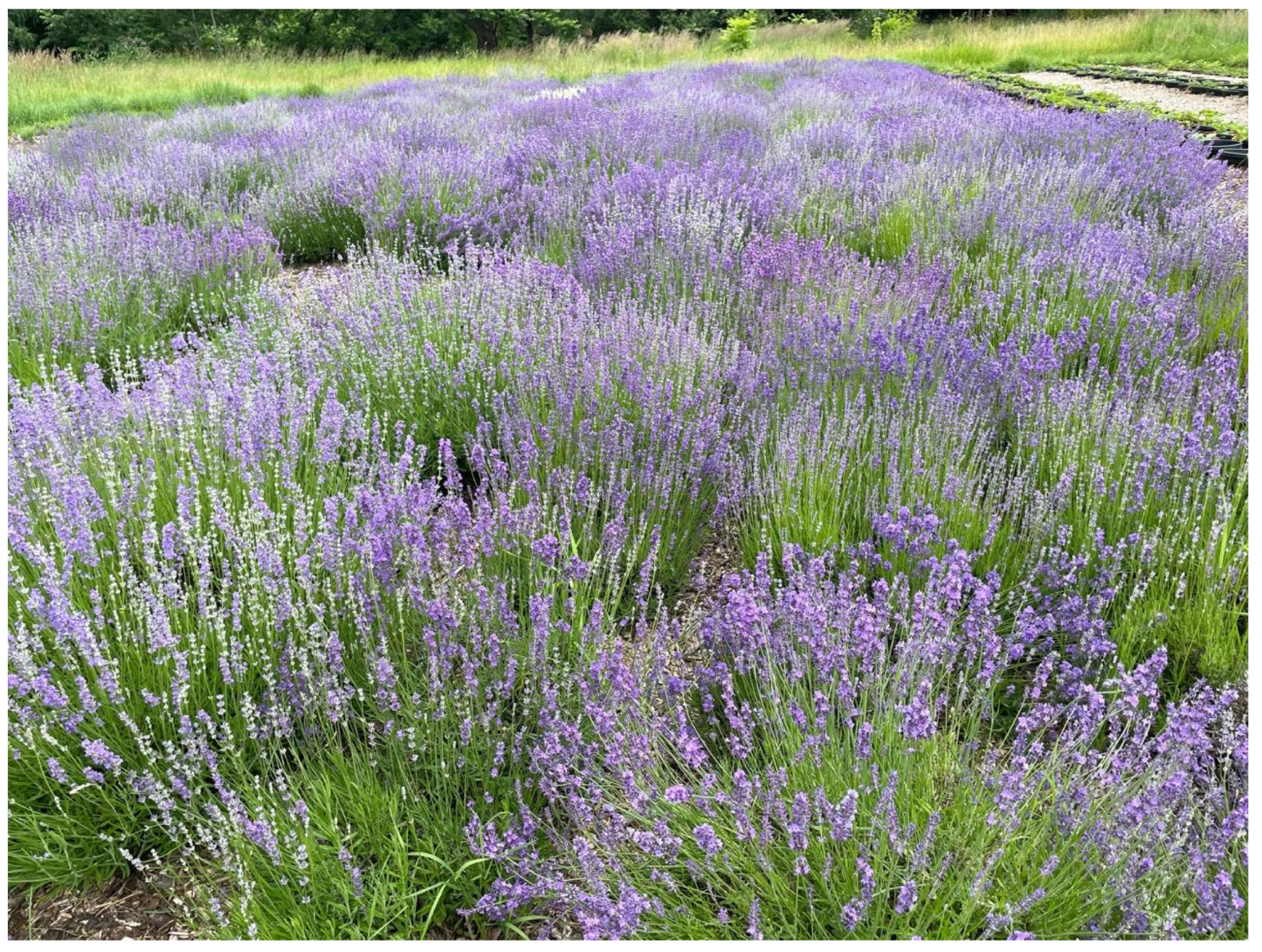
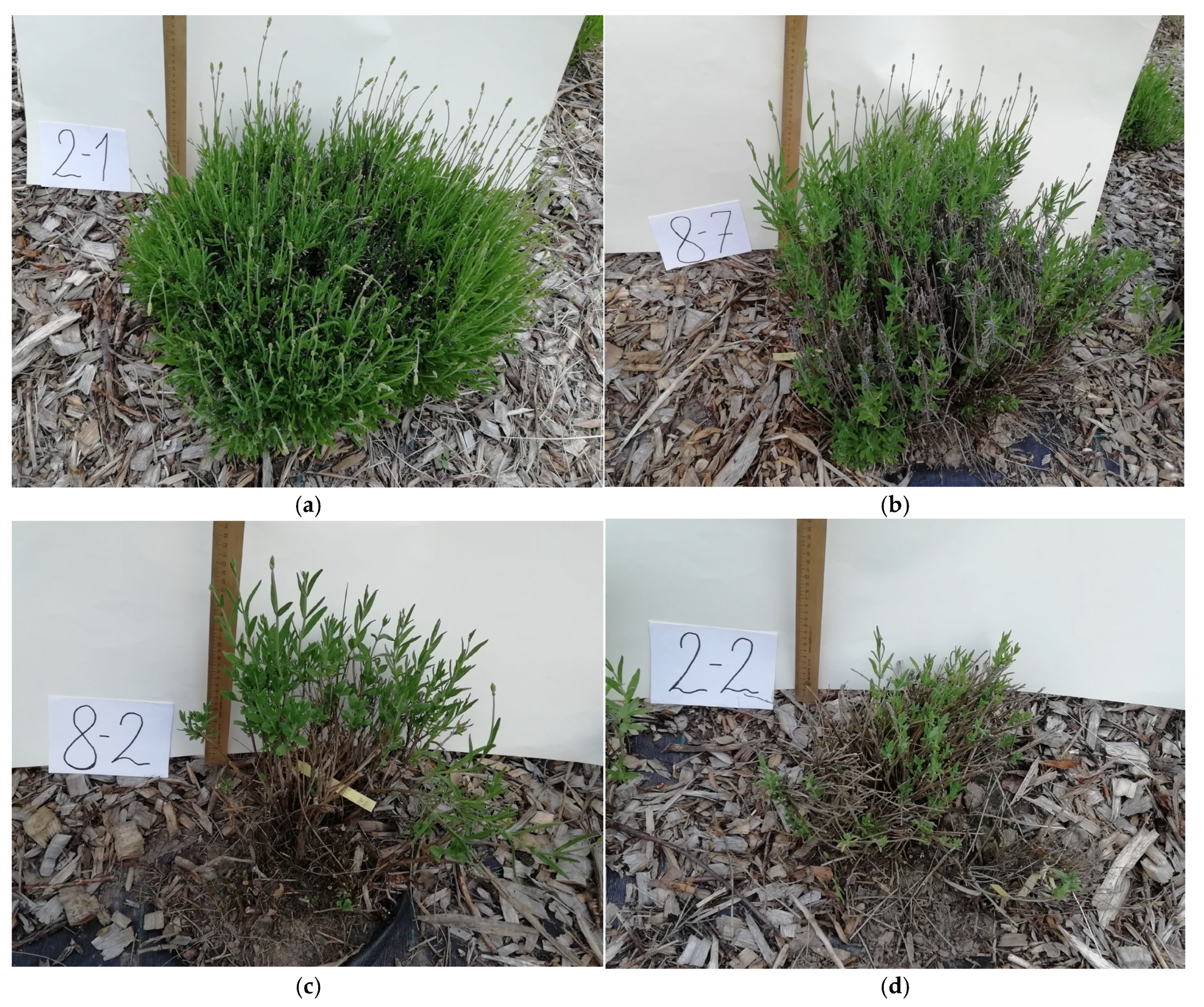
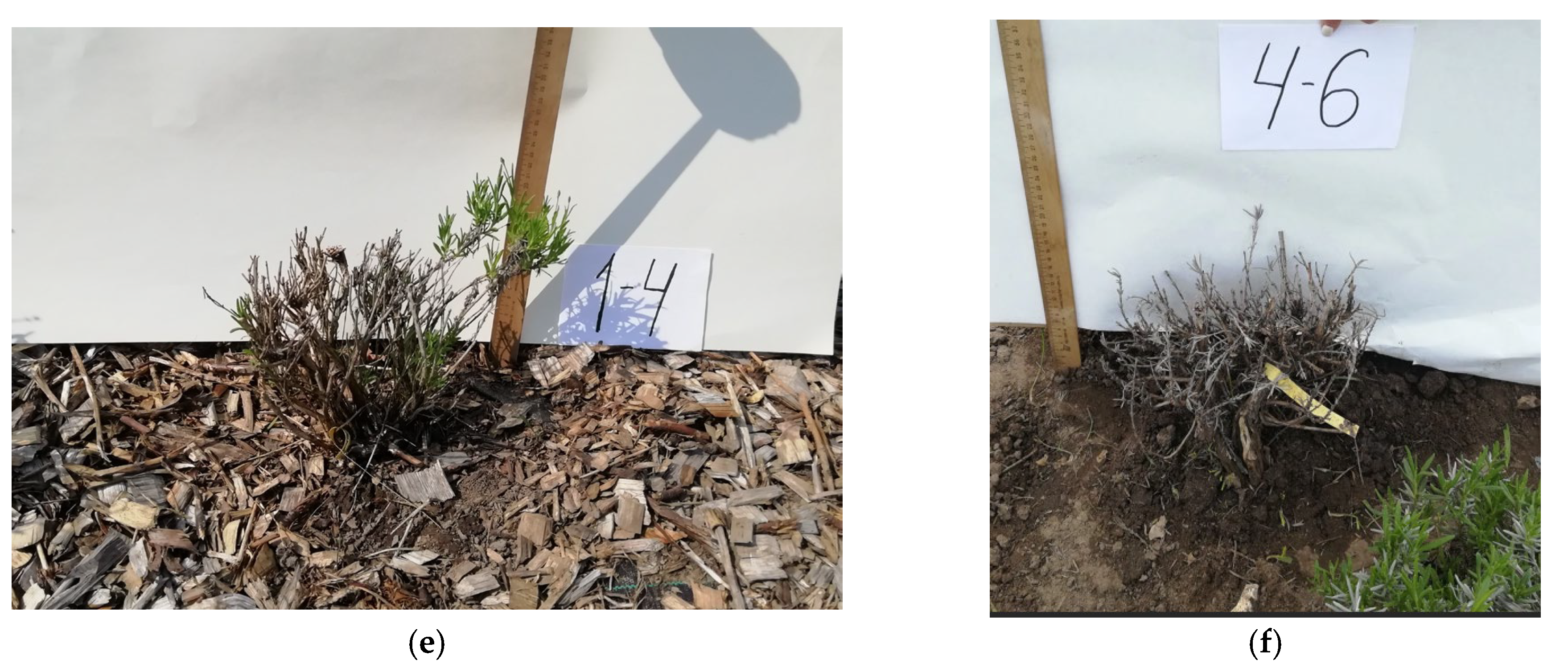
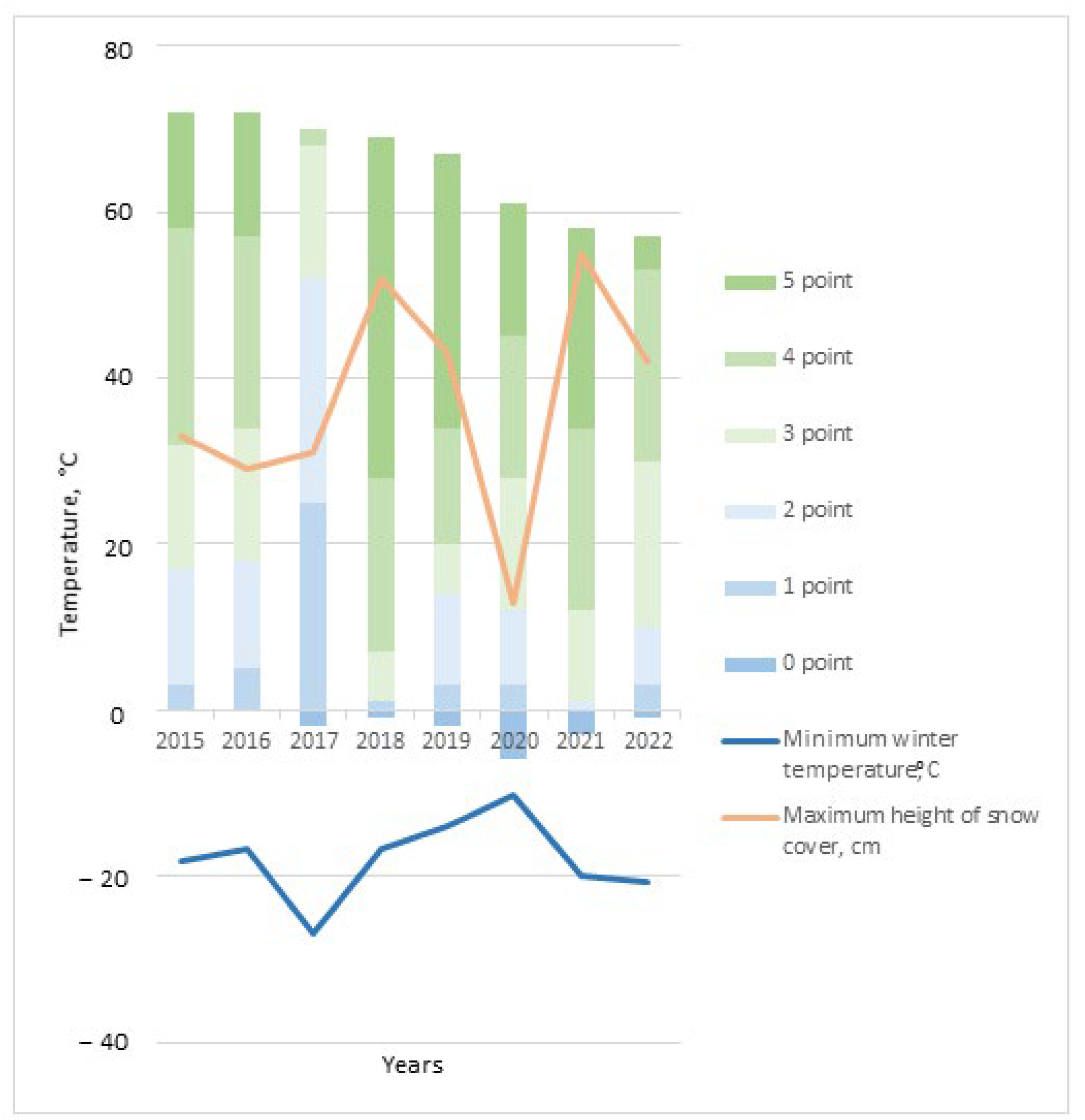
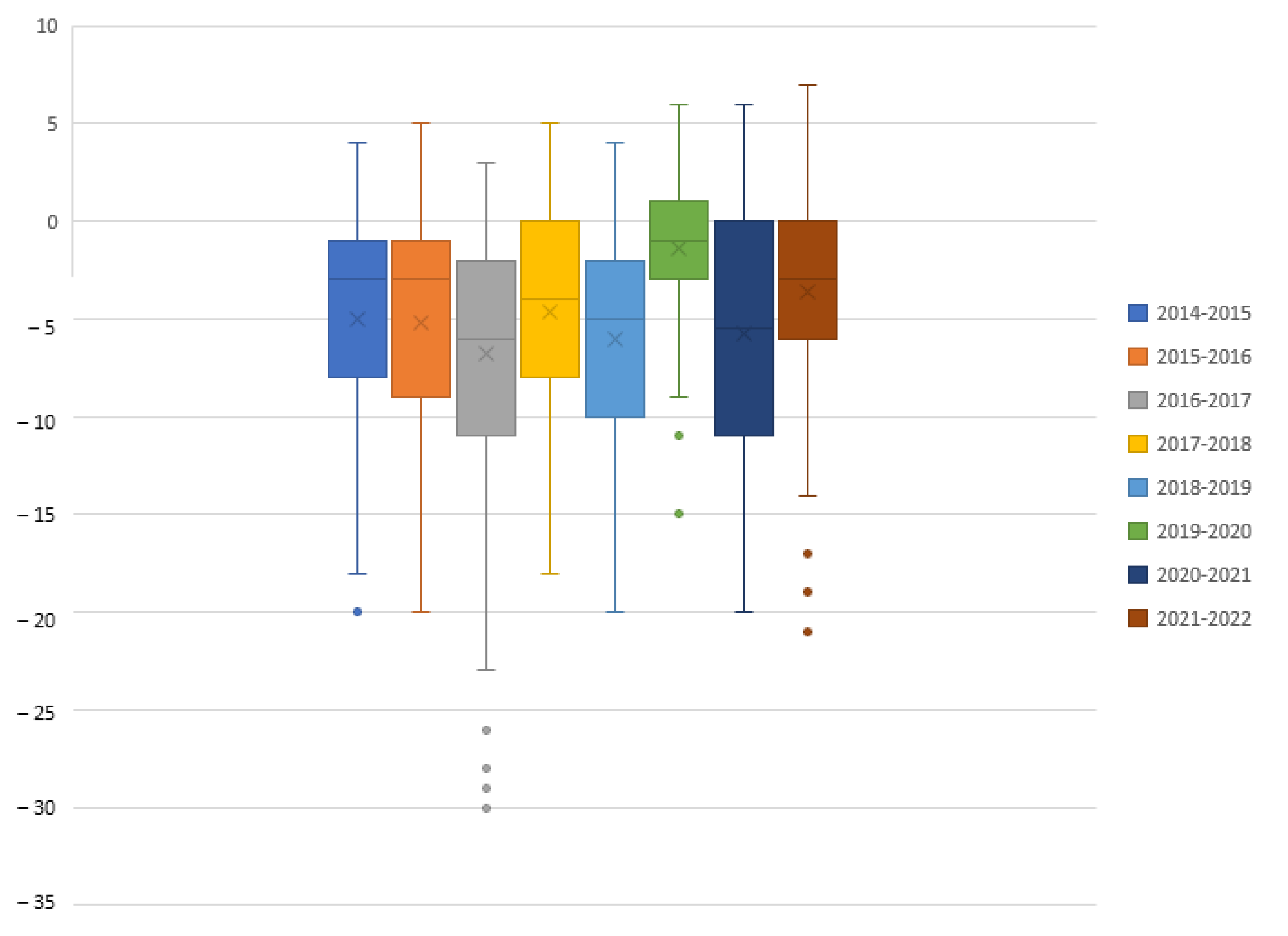
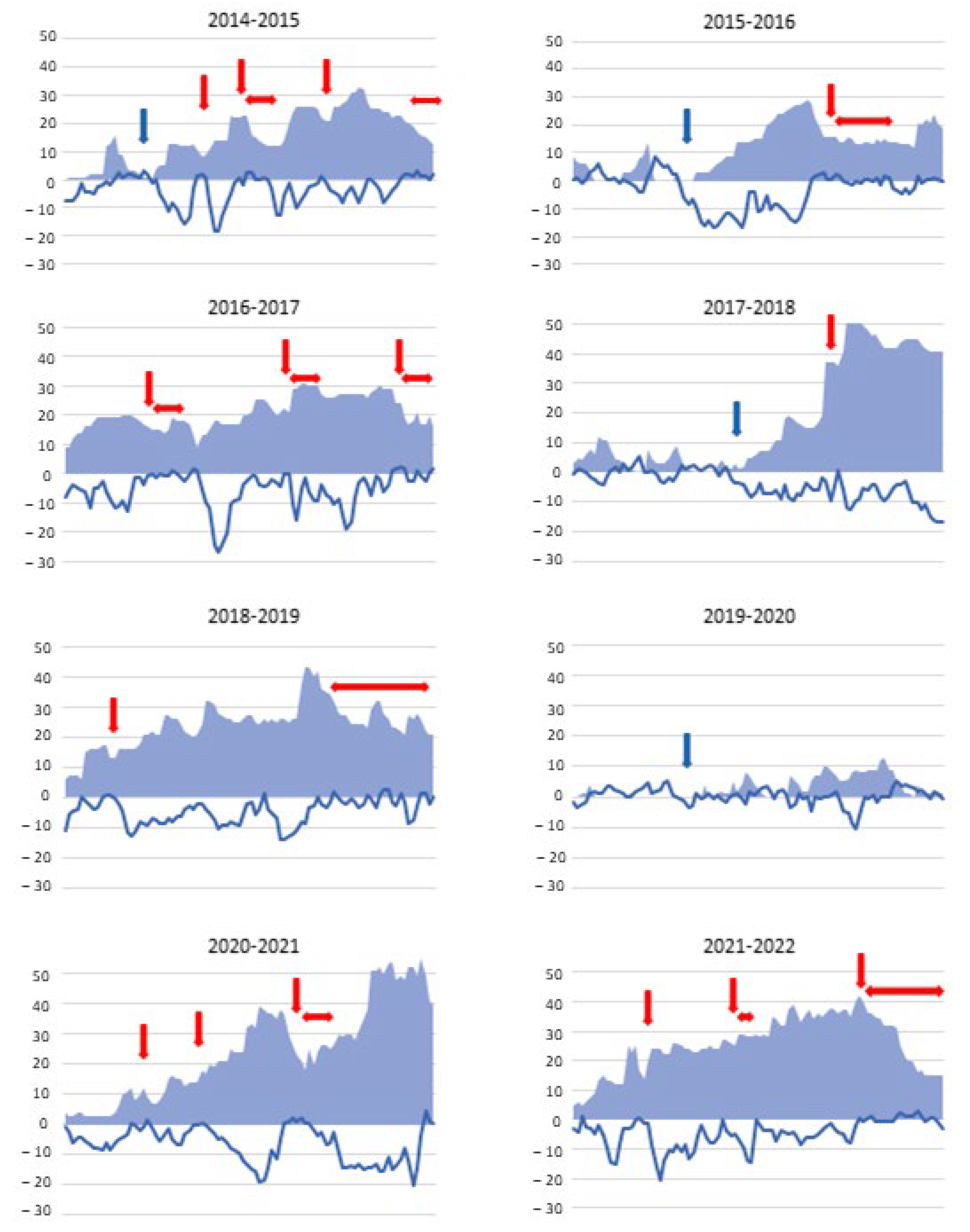

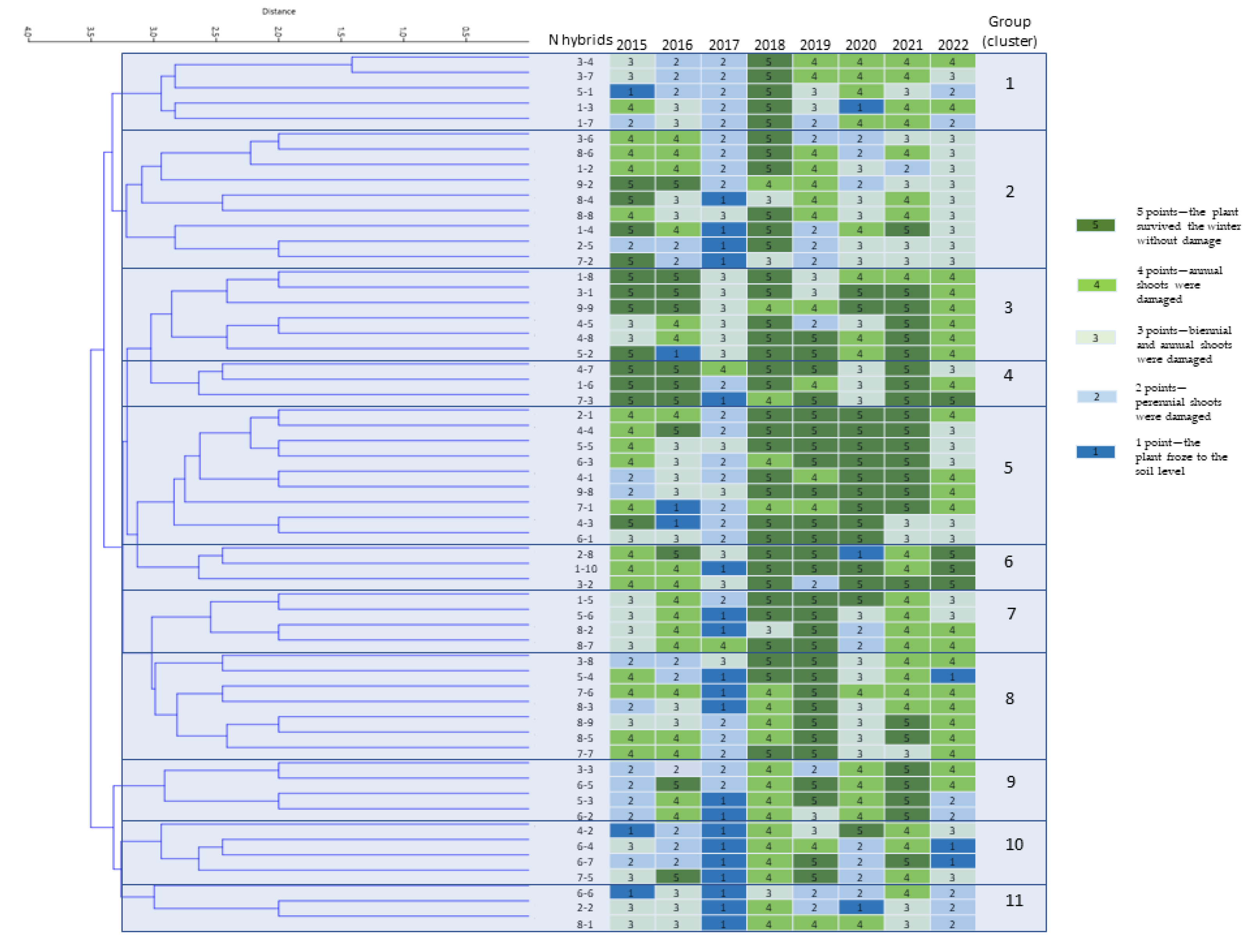
| Year | Mediana | Mode | Average Point | Overwintered Plants, % |
|---|---|---|---|---|
| 2015 | 4 | 4 | 3.5 | 100 |
| 2016 | 4 | 4 | 3.4 | 100 |
| 2017 | 2 | 2 | 1.9 | 97.2 |
| 2018 | 5 | 5 | 4.5 | 98.6 |
| 2019 | 4 | 5 | 3.9 | 97.1 |
| 2020 | 4 | 4 | 3.6 | 91.0 |
| 2021 | 4 | 5 | 4.2 | 95.1 |
| 2022 | 3 | 4 | 3.3 | 98.3 |
| Year | Minimum Winter Temperature, °С | The Sum of Active Temperatures Is Above 10 °C | Maximum Snow Cover Height, cm | Precipitation Amount for the Year, mm |
|---|---|---|---|---|
| 2015 1b | −18.3 | 2911 | 33 | 717 |
| 2016 1b | −16.8 | 2877 | 29 | 881 |
| 2017 3 | −27.0 | 2555 | 31 | 870 |
| 2018 1a | −16.7 | 3355 | 52 | 652 |
| 2019 1a | −13.9 | 3093 | 43 | 556 |
| 2020 2a | −10.3 | 2966 | 13 | 901 |
| 2021 2b | −20.0 | 2897 | 55 | 817 |
| 2022 2b | −20.6 | 3065 | 42 | 648 |
| Month | Ten-Day Period | 2014–2015 | 2015–2016 | 2016–2017 | 2017–2018 | 2018–2019 | 2019–2020 | 2020–2021 | 2021–2022 |
|---|---|---|---|---|---|---|---|---|---|
| Minimum temperature, °C | |||||||||
| December | 1 | −12 | −1 | −14 | −4 | −15 | −5 | −13 | −14 |
| 2 | −3 | −10 | −19 | 0 | −16 | −2 | −11 | −14 | |
| 3 | −17 | −10 | −4 | −4 | −10 | −4 | −11 | −21 | |
| January | 1 | −20 | −20 | −30 | −4 | −14 | −3 | −9 | −8 |
| 2 | −12 | −20 | −12 | −9 | −11 | −6 | −20 | −17 | |
| 3 | −18 | −19 | −23 | −10 | −20 | −7 | −9 | −8 | |
| February | 1 | −14 | −5 | −23 | −13 | −5 | −15 | −17 | −8 |
| 2 | −12 | −8 | −11 | −10 | −10 | −4 | −18 | −3 | |
| 3 | −2 | −8 | −7 | −18 | −12 | −5 | −17 | −3 | |
| March | 1 | −5 | −8 | −2 | −13 | −12 | −3 | −16 | −9 |
| 2 | −4 | −9 | −5 | −13 | −11 | −9 | −11 | −4 | |
| 3 | −10 | −10 | −6 | −6 | −3 | −6 | −2 | −4 | |
| Average temperature, °C | |||||||||
| December | 1 | −7.2 | 0.7 | −8.9 | −1.4 | −5.9 | −1.1 | −8.2 | −5.3 |
| 2 | −0.5 | −3.5 | −10.8 | 1.8 | −8.1 | 0.0 | −5.6 | −4.1 | |
| 3 | −9.5 | −0.6 | −2.0 | −0.7 | −9.1 | −1.0 | −5.9 | −12.8 | |
| January | 1 | −10.2 | −16.6 | −19.0 | 0.0 | −8.5 | −1.4 | −2.8 | −5.3 |
| 2 | −2.8 | −13.7 | −6.3 | −6.9 | −7.3 | −1.2 | −13.4 | −5.8 | |
| 3 | −9.3 | −9.4 | −10.0 | −6.0 | −12.3 | −2.8 | −0.8 | −5.1 | |
| February | 1 | −7.5 | −1.8 | −14.1 | −5.5 | −3.3 | −6.1 | −10.4 | −2.8 |
| 2 | −6.0 | −3.3 | −4.9 | −6.4 | −3.6 | −0.9 | −13.3 | 0.1 | |
| 3 | −0.5 | −3.8 | −3.9 | −14.4 | −5.4 | −1.5 | −5.8 | −0.1 | |
| March | 1 | −0.7 | −1.2 | 0.4 | −8.8 | −6.2 | 2.3 | −5.0 | −2.9 |
| 2 | −2.0 | −4.0 | −1.1 | −5.4 | −2.3 | −0.4 | −1.7 | 0.0 | |
| 3 | −2.8 | −4.2 | −1.8 | −1.5 | −0.5 | −2.2 | 2.2 | 1.4 | |
Disclaimer/Publisher’s Note: The statements, opinions and data contained in all publications are solely those of the individual author(s) and contributor(s) and not of MDPI and/or the editor(s). MDPI and/or the editor(s) disclaim responsibility for any injury to people or property resulting from any ideas, methods, instructions or products referred to in the content. |
© 2025 by the authors. Licensee MDPI, Basel, Switzerland. This article is an open access article distributed under the terms and conditions of the Creative Commons Attribution (CC BY) license (https://creativecommons.org/licenses/by/4.0/).
Share and Cite
Kryuchkova, V.; Evtyukhova, A.; Avdeev, S.; Donskih, V.; Shelepova, O.; Ladyzhenskaya, O.; Gorbunov, Y. Lavender Breeding for Winter Hardiness in a Temperate Climate. Horticulturae 2025, 11, 139. https://doi.org/10.3390/horticulturae11020139
Kryuchkova V, Evtyukhova A, Avdeev S, Donskih V, Shelepova O, Ladyzhenskaya O, Gorbunov Y. Lavender Breeding for Winter Hardiness in a Temperate Climate. Horticulturae. 2025; 11(2):139. https://doi.org/10.3390/horticulturae11020139
Chicago/Turabian StyleKryuchkova, Viktoriya, Anastasia Evtyukhova, Sergey Avdeev, Vitaly Donskih, Olga Shelepova, Olga Ladyzhenskaya, and Yuri Gorbunov. 2025. "Lavender Breeding for Winter Hardiness in a Temperate Climate" Horticulturae 11, no. 2: 139. https://doi.org/10.3390/horticulturae11020139
APA StyleKryuchkova, V., Evtyukhova, A., Avdeev, S., Donskih, V., Shelepova, O., Ladyzhenskaya, O., & Gorbunov, Y. (2025). Lavender Breeding for Winter Hardiness in a Temperate Climate. Horticulturae, 11(2), 139. https://doi.org/10.3390/horticulturae11020139







